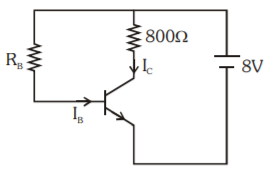A npn transistor conducts when
collector is positive and emitter is at same potential as the base
both collector and emitter are negative with respect to the base
both collector and emitter are positive with respect to the base
collector is positive and emitter is negative with respect to the base
The correct Answer is:D
To determine when an NPN transistor conducts, we need to understand its structure and the conditions required for it to operate in the active region. Here’s a step-by-step explanation:
Step 1: Understand the Structure of NPN Transistor
An NPN transistor consists of two n-type semiconductor materials (the collector and emitter) and one p-type semiconductor material (the base).
Step 2: Identify the Biasing Conditions
For an NPN transistor to conduct, the following conditions must be met:
- The emitter must be at a lower potential than the base (forward-biased junction).
- The collector must be at a higher potential than the base (reverse-biased junction).
Step 3: Emitter-Base Junction
The emitter-base junction must be forward-biased. This means:
- The emitter (n-type) should be more negative relative to the base (p-type).
Step 4: Collector-Base Junction
The collector-base junction must be reverse-biased. This means:
- The collector (n-type) should be more positive relative to the base (p-type).
Step 5: Conclusion
Combining the above conditions, an NPN transistor conducts when:
- The collector is positive with respect to the base.
- The emitter is negative with respect to the base.
Final Answer
An NPN transistor conducts when the collector is positive and the emitter is negative with respect to the base.
---
An NPN transistor consists of two n-type semiconductor materials (the collector and emitter) and one p-type semiconductor material (the base).
For an NPN transistor to conduct, the following conditions must be met:
- The emitter must be at a lower potential than the base (forward-biased junction).
- The collector must be at a higher potential than the base (reverse-biased junction).
The emitter-base junction must be forward-biased. This means:
- The emitter (n-type) should be more negative relative to the base (p-type).
The collector-base junction must be reverse-biased. This means:
- The collector (n-type) should be more positive relative to the base (p-type).
Combining the above conditions, an NPN transistor conducts when:
- The collector is positive with respect to the base.
- The emitter is negative with respect to the base.
An NPN transistor conducts when the collector is positive and the emitter is negative with respect to the base.
Similar Questions
A n−p−n transistor conducts when
View SolutionIn a transistor
View SolutionA npn transistor is connectedin CEC in which collector voltage drop across load resistance (800 ohm) connected to collector circuit is 0.8V The collector current is

View SolutionIn a transistor,
View SolutionIn npn transistor circuit, the collector current us 10 mA. If 95 % of the electrons emitted reach the collector what is the free current ?
View SolutionAn npn transistor operates as a common emitter amplifier, with a power gain of 60 dB. The input circuit resistance is 100Ω and the output load resistance is 10kΩ.The common emitter current gain β is :
View SolutionA npn transistor operates as a common emitter amplifier, with a power gain of 60 dB. The input circuit resistance is 100Ω and the output load resistance is 10kΩ. The common emitter current gain β is:
View SolutionIn a transistor circuit, when the base current is increased by 50μAkeeping the collector voltage fixed at 2 V. the collector current increases by 1 mA The current gain of the transistor is
View SolutionA transistor is a/an
View SolutionAn unknown transistor needs to be identified as npn and pnp type. A multimeter, wilth +ve and −ve terminals is used to measure resistance between different terminals transistor. If terminal 2 is the base of the transistor then which of the following is correct for a pnp transistor?
View Solution
